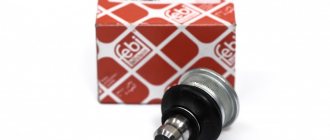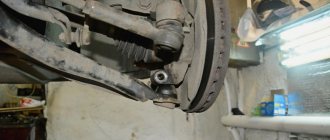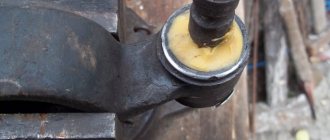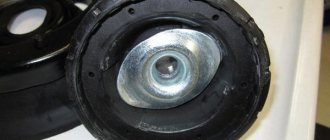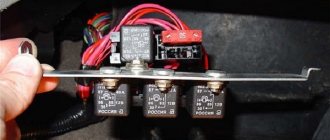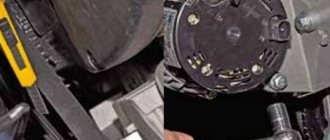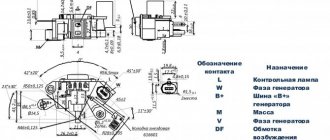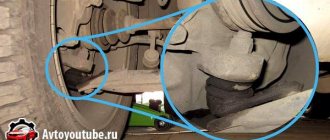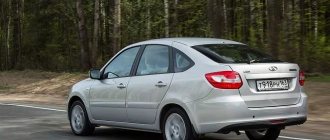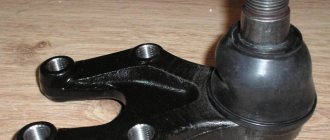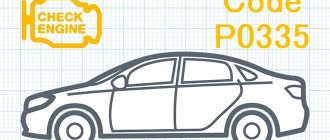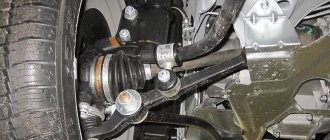If you experience knocking noises from the front suspension, especially when driving on an uneven road with small holes or potholes, you should pay attention to the condition of the ball joints. On a Grant, factory ball joints can easily travel more than 100,000 km during normal operation, but there are also cases when this has to be done much more often. It is for such cases that this article will be written.
In order to replace the ball joints on the Grant, we will need the following tool:
- Hammer
- Mount
- Puller
- Key for 17 and 19
- Torx head e12
- Ratchet or crank
Photo report on replacing ball joints on Lada Granta
The first thing you need to do is put the car on a lift or jack up the front of it. After this, remove the wheel to gain access to the front suspension elements.
Then unscrew the two bolts securing the support to the steering knuckle, as shown in the photo below:
Then, using a 19mm wrench, we tear off, but do not completely unscrew the lower nut attaching to the front suspension arm of the Grant:
And now you can use a special puller to press the ball joint pin out of the lever, or use a hammer and pry bar for this purpose.
After removing the finger, you can remove the support completely, move the lever to the side:
If it is not possible to move the lever to the side using a pry bar, then you can use a jack and a brick, as is clearly shown in the photo below.
We take a new ball, remove the boot and thoroughly push it inside with lubricant, such as Litol. After which you can install the new ball in its place. Of course, you will have to suffer quite a bit until the support gets into place, but if you have a jack and pry bars, everything can be done without any problems.
We tighten all the bolts and nuts to the required torque and put all the other parts in their places. With this, we can consider this repair of the Lada Granta complete. The price of a new ball joint is no more than 400 rubles for the original product from AvtoVAZ. There are cheaper options, but in this case you can save on both price and quality!
Ball joint replacement process
When you have decided on a spare part, you can carry out the replacement operation. So, let's look at the step-by-step process of changing the ball joint on Kalina:
- We dismantle the wheel.
- We clean the ball joint and all surfaces that connect to it.
- Unscrew the fastening of the ball joints.
- The stabilizer link also needs to be unscrewed for easy replacement.
- We bend the lever down.
- We take a special puller for balls and press it out of the lever seat.
- Installation is carried out in reverse order.
Peculiarities
Harsh operating conditions, poor road surfaces, loads and passengers place a lot of stress and responsibility on the ball joint. Therefore, the condition of this node must be monitored regularly.
The entire load does not go to the ball joint itself, but to a small ball, which can fall out if worn out and worn out. If you remember, not so long ago you could see a Lada car on the road with a fallen ball joint.
Other causes of ball failure
- Natural wear and tear. As mentioned above, each car part has its own lifespan. It all depends on many factors: the quality of the ball, the presence or absence of increased loads, car care, lubricant production, exposure to high and low temperatures, etc.
- Operation in extreme conditions. Breakneck speed, reckless driving on the roads, and constant off-road driving are a serious test even for the suspension that is designed for this. It is clear that the ball joint in such cases fails much earlier than in cars that are used exclusively in urban conditions.
- Lubrication production. Lubricants evaporate and dry out over time, and without them, the structure fails much faster. Moreover, even new parts should be lubricated additionally, since the manufacturer often leaves too little lubricant.
Ball failure usually makes itself known in advance. The main thing is not to turn a blind eye to these symptoms and go to the service station on time.
Symptoms of the malfunction Description of the breakdown When overcoming obstacles, knocking and other extraneous sounds are heard in the wheel area. A characteristic clanging and knocking sound is heard no matter how fast the car is moving. Extraneous sounds are best heard if the car is well loaded and the wheel hits a hole or any other pothole on the road. Even if the knock was heard only once (although this phenomenon usually repeats periodically), this is a reason to contact a specialist
Please note: knocking and clanging can also occur in winter (in sub-zero temperatures) if the lubricant in the CV joint freezes. The wheel alignment characteristics have changed. There are often cases when a problem cannot be detected with the naked eye. During a routine inspection at a service station, specialists will definitely warn you that the ball joint on one of the wheels has worn out and needs to be repaired.
The only visual sign that may indicate a malfunction is the “eating” of rubber on the edge of your car’s wheel. It has become more difficult to drive a car. When play occurs due to a broken ball joint. The wheel wobbles while driving, and this wobble is transmitted to the car: it is no longer able to drive smoothly. As the speed increases, handling only gets worse. Moreover, this symptom can be diagnosed at an early stage in cases where the car is driven exclusively on smooth city roads. If you constantly travel, go to the country or to the forest on dirt roads, the deterioration in handling will not always be noticeable. The wheels squeak when turning. Another sign of a bad ball joint is the squeaking noise that the front wheels make. If the sound comes from another place, the breakdown may be hidden by the steering rack or power steering. Tires wear unevenly. As a result of damage, the steering wheel ball occupies an uneven position and is at an angle to the road surface. In this case, along its inner edge (which is closer to the engine), the tread begins to wear out more than on the remaining surface of the tire. This malfunction can be detected both visually and by ear: the damaged wheel beats while driving. The trajectory of the car changes directly during braking. If you notice that the car goes sideways when braking, then most likely it has a damaged ball joint. Moreover, the car always tilts exactly in the direction on which the faulty spare part is located. One of the wheels will be tilted due to wear on the ball joint, and will begin to make characteristic clicks during braking.
In order to correctly diagnose damage, it is necessary to carefully check the entire suspension. A car is a complex piece of equipment that only works properly if all its elements are in order. And one breakdown can lead to another over time.
This is why it is so important to diagnose the problem at an early stage. This will help you avoid unnecessary expenses and save your nerves
Reasons for failure
There are several reasons why a ball joint may fall out. Let's consider the main ones:
- Wear . The most common malfunction that occurs on cars.
- Insufficient lubrication in the boot leads to the fact that the finger begins to creak and may eventually simply break.
- The penetration of dirt and water into the ball contributes to the development of corrosion, which can affect the operation of the vehicle. At best, a wedge and the inability to turn the wheels; at worst, the car will fall onto the asphalt.
Ball selection, articles
The choice of ball joints for the Lada Kalina should be treated carefully, since it determines what loads the car can withstand:
Original
If you believe the spare parts catalog, then the original catalog number of the Lada Kalina ball joint is 2108-2904185 . The average cost is 1000 rubles per piece.
Analogs
Let's consider possible options for replacing the original spare part:
As you can see from the table, you can buy an analogue cheaper than the original. But don’t go to extremes and buy the cheapest.
conclusions
The process of replacing ball joints on the Lada Kalina is quite simple and easy. But, it is worth paying attention to the choice of part, since how long and how well it will hold the suspension depends on its quality.
If you are going to drive a car in winter, it would be a good idea to check the condition of the chassis and transmission so that you do not have to do repairs right on the road, in dirty snow slush. Any Granta owner can save both time and money if they check the car themselves. Today we are talking about the chassis and transmission.
LADA > Granta
Required tools and materials for replacement
To independently replace the ball joint on a Lada Granta car, you need the tools from the list below.
Table - Tools and materials required to replace the ball joint.
| Name | Note |
| Socket head | Torx E12 |
| Vorotok | Under the end cap |
| Ball joint remover | Makes it easier to remove the ball joint from its seat |
| Balloon wrench | For dismantling and installing wheels |
| open-end wrench | "at 17", "at 19" |
| Hammer | Required if you do not have a ball joint remover |
| Jack | To lift the car |
| Wheel chock | For fixing the rear axle |
| Penetrating lubricant | To make it easier to unscrew stuck threaded connections |
| Grease | To fill the boots in case the manufacturer has supplied too little lubricant |
| Rags and wire brush | For cleaning fasteners and working surfaces |
Ball joint puller
Cover granta var2.indd
We check the chassis and transmission every 15 thousand kilometers.
We carry out the work on an inspection ditch or overpass.
The parts of the chassis (wheels, suspension arms, anti-roll bar, rear suspension beam, shock absorbers and suspension springs) and transmission (front wheel drive shafts) must be free of deformations, cracks and other mechanical damage that affect the shape and strength of the parts.
Hanging the front wheels one by one (while the car must be securely fixed on the support stand), we check the condition of the wheel hub bearings.
Use only factory-made support stands.
The wheel should rotate evenly by hand, without jamming or knocking.
How to change the ball on a grant?
March 15, 2022 Lada.Online 17,645
According to the maintenance regulations for Lada Granta, Lada Kalina and Lada Priora cars, the technical condition of the front suspension parts must be checked every 15,000 km. mileage You can determine the causes of knocks and squeaks in the suspension using self-diagnosis.
Layout of front suspension parts
1 — anti-roll bar; 2 — rubber-metal joint of the transverse arm; 3 — shock absorber strut; 4 - stretching; 5 — extension bracket; 6 — nut for fastening the extension to the bracket; 7 — ball support of the shock absorber strut; 8 — joint of the anti-roll bar; 9 — wishbone; 10 — bracket for securing the stabilizer bar.
How to check the front suspension
Checking the front suspension should be carried out in the engine compartment and from below the car, mounted on an inspection ditch or supports (with the front wheels hanging out).
The condition of the protective covers of the suspension ball joints (they should not be mechanically damaged) should be checked during each maintenance and repair of the vehicle.
Check the condition of the rubber-to-metal joints, rubber cushions, suspension ball joints and the condition of the upper suspension strut mounts.
Rubber-metal hinges and rubber cushions must be replaced in case of ruptures and one-sided bulging of rubber, as well as when their end surfaces are trimmed.
Suspensions on rubber parts are not allowed:
- signs of rubber aging;
- mechanical damage.
Pay special attention to mechanical damage (deformations, cracks, traces of contact with road obstacles, etc.) of suspension elements, especially levers.
Procedure
:
1. Check the tightness of the shock absorber rod mounting nut.
2. Check the tightness of the nuts securing the upper strut support to the body. Similarly, check the fastenings of the rod and the upper support of the second rack.
3. Check the condition of the protective covers of the ball joints. If the boots are damaged, replace the ball joints.
4. Check the ball joints for play. To do this, measure the distance H (see Fig. 7.1) between the transverse arm 17 and the brake disc 21. Insert the mounting blade A (see photo) between the steering knuckle and the suspension arm and, leaning on the lever, try to swing the steering knuckle. If this distance changes by more than 0.8 mm when the suspension is rocked, replace the ball joint.
5. If the ball joints are in good condition, rock the wheels in a vertical plane and make sure there is no play in the hub bearings. The maximum permissible axial clearance is no more than 0.015 mm. If the gap is greater than the specified value, replace the bearings.
Advice
: When swinging the suspended front wheel, it is difficult to distinguish play in the hub bearings and ball joints. Ask an assistant to press the brake pedal: if you feel play in this case, then the ball joints are faulty.
6. Check the rubber-to-metal joints in the places where the transverse arm is attached to the body bracket for play.
7. To do this, insert a mounting spudger or a large screwdriver into the gap between the lever and the bracket and try to rock the lever. If there is significant play, it is recommended to replace the lever assembly with hinges.
8. Check the rubber-metal hinges for attaching the stabilizer struts for play. To do this, insert the mounting blade between the wishbone and the stabilizer bar and rock the bar. If necessary, replace the stabilizer links.
Granta 39 7 new size
The suspension springs must not be damaged. Tearing, cracking and severe deformation of rubber bushings, cushions and compression buffers of shock absorbers are unacceptable.
Liquid leakage from shock absorbers is not allowed. A slight “fogging” of the shock absorber in its upper part, while maintaining the characteristics, is not a malfunction.
If the rubber element of the upper support of the front suspension telescopic strut settles or is destroyed, the support must be replaced.
How to check the condition of the front suspension of Lada Granta, Kalina and Priora
March 15, 2019 Lada.Online 20 911
According to the maintenance regulations for Lada Granta, Lada Kalina and Lada Priora cars, checking the technical condition of the front suspension parts must be performed every 15,000 km. mileage You can determine the causes of knocks and squeaks in the suspension using self-diagnosis.
